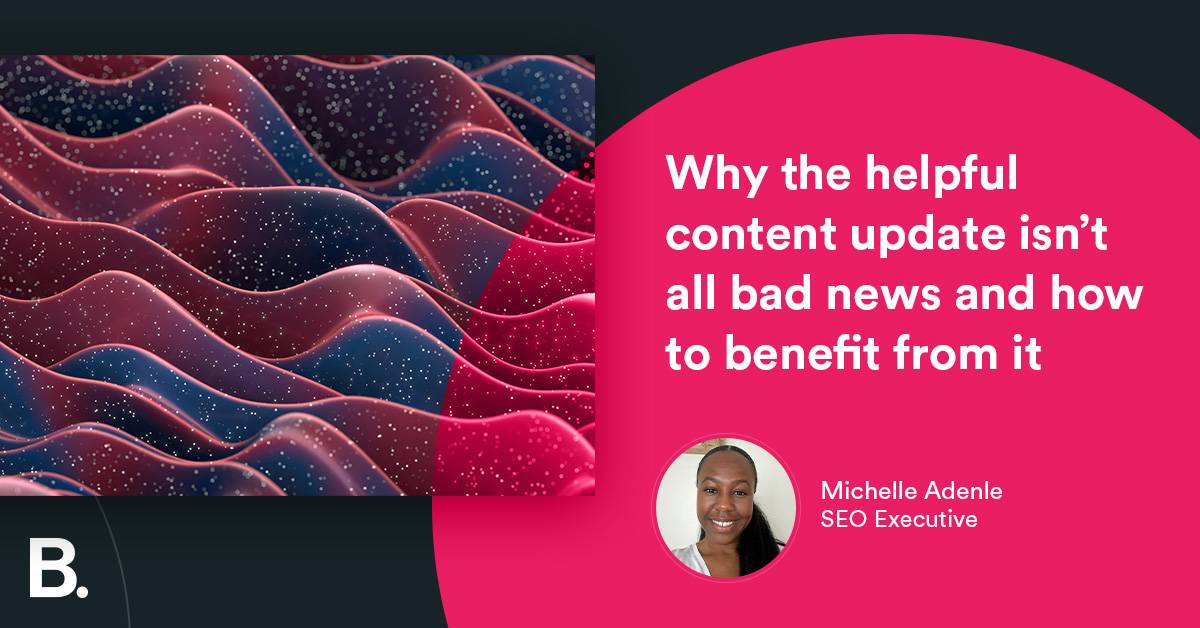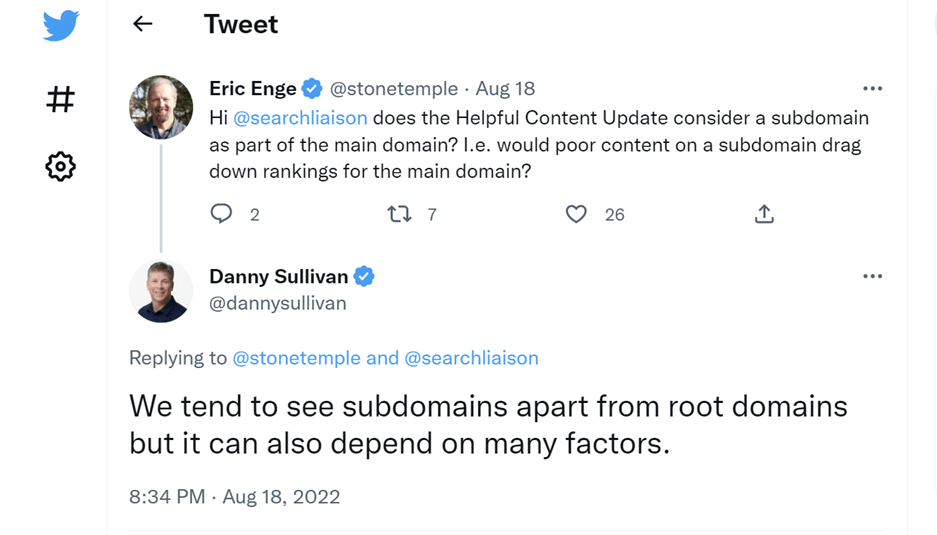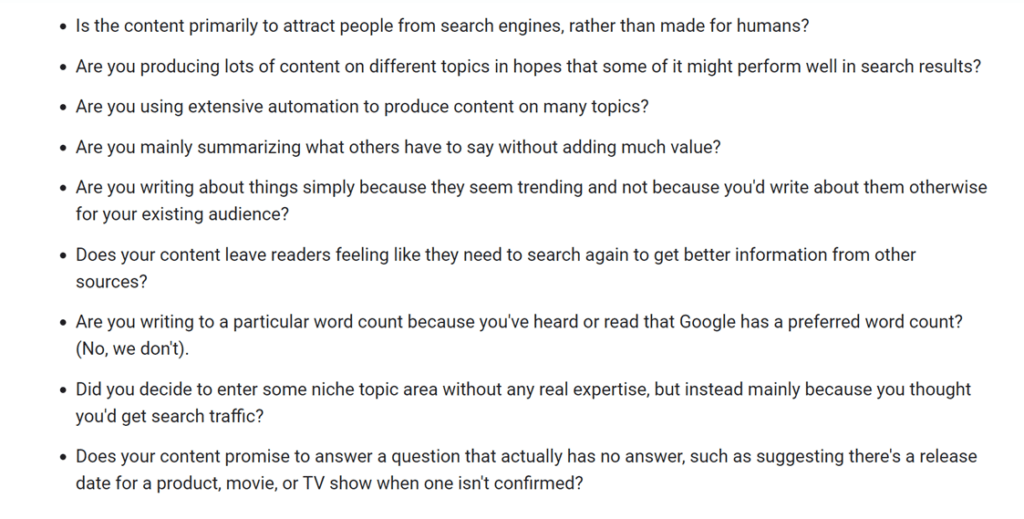
The Helpful Content Update – What it is
The new ranking signal targets content created purely to rank on search engines. Content with “little value” or which is “not particularly helpful” will see their rankings drop. With Google’s push to reduce the amount of low quality content on SERPs, websites with a large proportion of unhelpful content will negatively impact from this update. The focus is to provide a better experience for people searching on Google. Thus, this update “aims to reward sites that leave users feeling satisfied”.
What does this mean for website owners and, particularly, ecommerce sites?
Visibility is essential in boosting brand awareness, yet having large amounts of unhelpful content will result in lower rankings. Content quality at scale has always been a problem for ecommerce SEO, which typically suffer from issues such as thin content, duplicate content and large amounts of orphan expired product pages that haven’t been retired effectively.
Allowing these issues to continue will put your site at risk and quite possibly lead to ranking decreases, lower traffic and, therefore, less sales. Fixing these will be essential to successful organic performance.
The Helpful Content update – What it isn’t
1. A positive ranking signal.
The helpful content update is a negative ranking signal, not a positive one. Furthermore, the overall domain is unlikely to perform well if it has a large proportion of unhelpful content.
The quote below explains Google’s thoughts on this:
Our systems automatically identify content that seems to have little value, low-added value or is otherwise not particularly helpful to those doing searches.
This negative ranking signal flags domains with unhelpful content to Google. However, bear in mind that Google does not look at this signal in isolation; instead, it is considered amongst many other signals for ranking web pages.
2. It doesn’t affect subdomains the same as main domains
As Danny Sullivan explains below, the helpful content update affects main domains and subdomains differently. For example, a negative signal from this update to one domain will not automatically affect a subdomain. If both domain and subdomain are filled with low quality content, then it’s likely both the domain and subdomain will be hit by the update.

3. It’s not finished
The August helpful content rollout was complete on the 9th of September 2022 but this does not mean it’s all over. The signal is applied over a period of months and is being fine-tuned to provide more useful SERP results. Now, the newer December 2022 rollout has “improved classifiers and works across content globally in all languages”.

Furthermore, Google announced the “classifier for this update runs continuously, allowing it to monitor newly-launched sites and existing ones”. For this reason, in order to avoid ranking drops and therefore revenue loss, businesses need to ensure they have a large proportion of useful content on their domains to avoid being flagged by this signal overtime.
How does the Helpful Content update work?
This algorithm is a machine learning system which automatically identifies content with little value and helps Google evaluate page rankings by monitoring the quality of a site’s contents over a period of time. Sites with a large number of unhelpful content are likely to be flagged by this signal. However, if you get hit by this update, you won’t get notified in Google Search Console like you would when getting a manual action.
Think of it like a weight holding down your rankings. This signal can impact site-wide rankings including higher quality content. For example, I have 100 posts on a domain and 90 of those posts are unhelpful whereas only 10 are helpful. With a larger proportion of low quality content on the domain, it’s likely the good quality content will also be harder to rank.
This signal, however, is considered among many other signals for ranking web pages. This means high-quality content can still rank in Google even if the site is identified as having unhelpful content. This is because Google uses many other factors to determine page rankings. Hence, if other signals identify the page to be of use, then Google can deem the page as relevant for a specific user’s query.
How to respond to the Helpful Content update
There is no doubt that having valuable content is an important ranking factor in SEO. However, despite this, it’s still quite common to see poorly written AI content, such as very thin pages or masses of stolen or duplicate content. An example of this would be large amounts of product descriptions stolen from manufacturer sites, which too often end up being duplicated across a number of online stores. The helpful content update is a way for Google to take back control and put people-first content back at the top of their SERPs.
James, one of our SEO Consultants here at Builtvisible, expressed the following view below:
Anything introduced to improve the quality of content created by website owners is a good thing, hence why I welcome the Helpful Content Update. I hope it brings a more significant shift in people’s mindset from satisfying search engines to the individuals making the search. If you can meet intent with helpful content supported by a seamless experience, you’ll go a long way to meet Google’s expectations, which will no doubt benefit you in the long run
If you think you might have been impacted by this update, have a good look at Google’s guidance. This post will help break down Google’s thoughts with 5 tips on providing helpful content.
1. Stay niche
Focusing on a particular niche will help you become an expert on that specific topic area. It’s likely people will seek answers and buy products from a niche-specific site, as opposed to a site which covers a much broader set of topics more superficially.
By doing this, your brand will grow an audience who trusts you and naturally you’ll become an authority about topics that relate to your particular industry, product or service. It is therefore very important to have a clear target audience and content that answers their queries and solves their problems.
In their official documentation, Google asks:
“Are you producing lots of content on different topics in hopes that some of it might perform well in search results?”
“Does your site have a primary purpose or focus?”
In other words, writing about topics out of your niche results in unhelpful content overall. Don’t write irrelevant content.
2. Prioritise readers
Google explained that the reason behind the update is to see “helpful content written by people, for people, in search results”. According to them, web pages need to match user intent by providing information searchers are looking for. Brands can do this by assessing search queries and identifying what type of user intent each of these relates to.
With an informational search, for example, a user might want to find specific information about a product or service. However, when looking to make a purchase, a transactional query would be used instead. Understanding what the user expects to see in search results is vital in creating content that will leave the user satisfied. If your content doesn’t fulfill this intent effectively, then Google will not rank it.
At Builtvisible, we’ve built our own intent model using machine learning and NLP. This is providing better results for our clients than the industry leading tools on the market.
3. It might be time for a content audit
How useful is your content to the reader? This is the sort of question a content audit will help you answer.
As explained earlier, this update will have site-wide effects if your site has a large proportion of unhelpful content. For this reason, pruning your websites’ content can be an effective way to ensure your pages are deemed helpful by Google and prevent your site from being flagged by this signal.
With over a decade of industry leading SEO and specialisms in content, our content audits do exactly that.
4. Focus on E-A-T
In order to increase your content authority in line with E-A-T, it’s important to create valuable content written by someone with first-hand experience. To benefit from this update, stick to your industry knowledge and skills and avoid writing content you have no expertise in, as recommended by Google:
“Does your content clearly demonstrate first-hand expertise and a depth of knowledge (for example, expertise that comes from having actually used a product or service, or visiting a place)?”
It’s clear that Google values websites that demonstrate real expertise, authority and trustworthiness, as these help to determine a websites’ content quality and credibility. So, if you really want to perform successfully organically, you’ll need to make sure your content is optimised for E-A-T.
Furthermore, Google doesn’t want sites to purely “summarise what others are saying without adding much value” so, adding something new to the conversation can also be a great way to ensure content uniqueness, which will help you benefit from the helpful content update.
5. Check Google’s advice
If you haven’t read Google’s guidance on the helpful content update, then it’s time for you to give it a read. There Google explains their goals for the update and its direction going forward regarding content ranking in SERPs.
They ask a variety of questions, some of which you have seen throughout this post. Below is the full list of questions you’ll want to avoid answering yes to.

Need help with the Helpful Content update?
This update is a reminder for site owners and businesses to stop creating content purely for search engines but to focus on the people using it instead.
With Google’s constant efforts to satisfy searchers, it’s now more important than ever to focus on your audience and ensure your content is solving your audience’s problems. Failing to do this effectively will result in lower rankings, traffic and leaving potential sales on the table.
At Builtvisible, we specialise in creating, improving and pruning content that helps our clients rank effectively and achieve their financial goals. If you feel you might need some help with your website’s content, feel free to contact us via this form.



